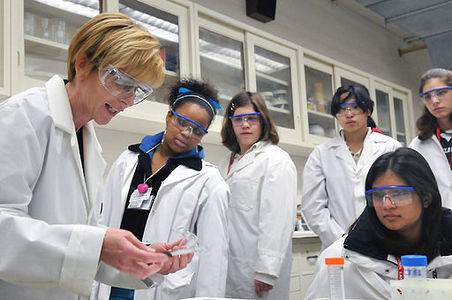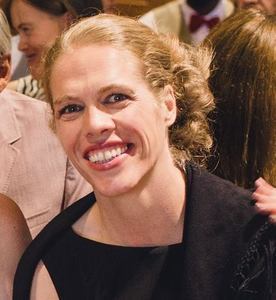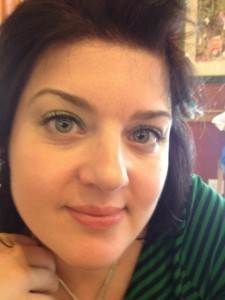Hi. My name is Melissa and I am a thyca survivor. My story begins one day when I was swimming in the pool at the gym and out of nowhere I noticed that I was starting to have a hard time breathing. It was different than hyperventilating because I was aware of how that felt; it was more like something was constricting my air. Mind you, at that point, I had been working out for years and had never had a problem of this nature. So when I started noticing it and it continued to get worse, I decided to make an appointment with my PCP who basically said it was allergies, gave me a prescription for allergies and sent me on my way. However, that didn’t help and I was worried that it was something else. Since I did not need a referral for my insurance, I made an appointment with an ENT that a friend of mine goes to. All this was in March of 2005. The ENT had X-rays of my sinuses done and ordered CAT scans. While reviewing the CAT scans of my sinuses, he was performing a standard a check and said “Did you know that you have a lump on your thyroid?”
That question led to a multitude of tests from thyroid ultrasound to Fine Needle Aspiration (FNA) sonogram guided biopsy and eventually to a partial thyroidectomy, removing the left side of my thyroid on Friday, August 12, 2005. The frozen nodule biopsy did not show signs of cancer. My family and I were so relieved and the ENT told my family, “No wonder she was having trouble breathing; there was a tumor almost the size of a tennis ball pressing against her wind pipe!”
Well, I was relieved but don’t remember much from the day of surgery because the anesthesia hit me hard, and I never woke up until 10:00 that night at which time I wanted food. The cafeteria was closed, but they were able to get me chicken broth and crackers. Yuck. My parathyroid glands were fine since I had an excellent surgeon, so the next day I was ready to go home for recovery.
By Monday, the doctor’s office tracked me down at my parents’ house where I had gone for recovery to get me in to see the doctor ASAP. I remember hanging up the phone and my dad asked me what was wrong – he hugged me and I cried.
So, by Wednesday that week, we drove back to Erie to meet with my ENT surgeon who proceeded to tell me that the tumor was a 4 cm follicular carcinoma mass which he said was encapsulated and proceeded to give me my options of leaving the remainder of the thyroid and having RAI (Radiation Ablation Iodine) or having it removed then having RAI. I chose to have it removed. By Friday, one week later, I was having a second surgery to remove the remainder of my thyroid. I kept joking with my family that the incision from the first surgery was like a zipper that they were going to just unzip and remove the rest. Again, I had to spend the night in the hospital and the next day I was at the nurse’s station begging to go home. Hospital stays are not my favorite thing. My calcium levels were good, my parathyroid glands were holding their own so I was permitted to go back to my parents’ home in Clarion for recovery and return to Erie in a week for suture removal and surgery follow up. From what I remember, since it’s been seven years, my ENT put me on Cytomel after my surgery. I don’t remember the dose.
The follow-up appointment day was less tense than the week before since the major part, the surgeries, were already done. We received the results of the second pathology and it was a good decision to go ahead with the second surgery because the right side showed a focus of follicular variant papillary carcinoma. The time frame before surgeries and RAI seemed like forever. I had my RAI in November of 2005. I went back to work after four weeks, which ended up being too stressful for me. As a result, I had to consult with my doctor and have that changed to part time for a couple weeks to let my body adjust to having no thyroid and coping in a stressful work environment. I suffered extreme fatigue and had a hard time focusing at work.
In the meantime, my ENT set me up with RAI and had me start Synthroid after RAI.
RAI was a challenge because of hormone withdrawal and having NO thyroid and trying to push myself everyday to still work full-time. This was tough, but I managed to function. They administered 168.8Mcis and sent me on my way home for isolation for a week. Not fun. I was fortunate that my only side effect at the time was fatigue and a horrible metallic taste that lasted for quite a while. A few months later, I ended up with salivary gland issues. Also not fun.
After my isolation was up, I went back to work full-time. I don’t know how I held up but I managed to function. Adrenaline kept me going most days; then I would go home and crash hard.
I did not have an endo in the picture until 2006. I do not remember the exact date. This began TSH suppression and years of what I refer to as “thyroid crap.” I did not tolerate TSH suppression well and had many side effects that I counteracted with various prescriptions. The first couple years were struggles and worries of whether or not the cancer was gone. After five scans and clean ultra-sounds, I remain cancer-free. Thank goodness!
However, the struggles were not just with TSH suppression. My first scan was administered with hormone withdrawal and it was horrible. I managed to keep working full-time up until I had to take the radioactive iodine pill for the scan. Then I took a few days off work because of the I-131 scan dose, not to mention the fact that I was extremely run down. After that, I went back to work full-time and waited to hear from the doctor’s office about when I could go back on my Synthroid. One week went by; no call. So I began calling and was told the CRNP[1] was on vacation. The endo’s office was going through a move at that time also, so it was chaos for their office staff. I gave up and put myself back on my Synthroid. I had to function.
Somewhere in this craziness, I found a flyer at my endocrinologist’s office on thyca from the Thyroid Cancer Survivors’ Association. I joined their Yahoo support group to help me through the challenges I faced. I have since became a member of this association so that I can help others as they have helped me.
Seven years later, and five clean scans and many clean ultrasounds: I am ready to take control of my life again. I am very sensitive to Synthroid changes and TSH suppression. Now I am hypothyroid for no apparent reason and have an endo who doesn’t seem to care about getting to the root of the cause. His answer is to keep increasing my Synthroid until the TSH goes back down and the Free T4 goes up. He says that I am converting enough Free T3 and refuses to put me on a T3 medication. Also, he does not even consider any other regimens such as NDT. Endocrinologists like this are the true reason that we need ThyroidChange.
I encourage everyone to get their necks checked frequently. If you have an annual physical, have your doctor check it then.
As I sit and write my story, I realize that I haven’t even touched on many of the issues that I would have liked to as it would probably end up being way too long.
What I would like for you to take from this story, is remember that you know your body. If something does not seem right, then get it checked out.
Don’t settle – it’s your body and your health. Be your own advocate!
Although my situation is still a work in progress, I now possess more knowledge to continue the fight against cancer and I am now against what I feel is inadequate thyroid treatment. Thank you to ThyCa, Thyroid Sexy, Half Pint, ThyroidChange, Stop the Thyroid Madness and all other individuals and groups that have helped me.
As I work to remedy my own struggles, I also thrive to help others through theirs.
Good luck in your journeys and best of health!
[1] Certified Registered Nurse Practitioner
This article was posted previously on ThyroidChange and re-posted with permission.













































